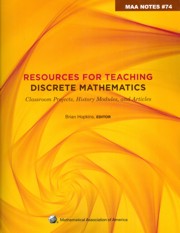Book contents
- Frontmatter
- Introduction
- Dedication
- Contents
- I Classroom-tested Projects
- II Historical Projects in Discrete Mathematics and Computer Science
- III Articles Extending Discrete Mathematics Content
- IV Articles on Discrete Mathematics Pedagogy
- Guided Group Discovery in a Discrete Mathematics Course for Mathematics Majors
- The Use of Logic in Teaching Proof
- About the Editor
The Use of Logic in Teaching Proof
from IV - Articles on Discrete Mathematics Pedagogy
- Frontmatter
- Introduction
- Dedication
- Contents
- I Classroom-tested Projects
- II Historical Projects in Discrete Mathematics and Computer Science
- III Articles Extending Discrete Mathematics Content
- IV Articles on Discrete Mathematics Pedagogy
- Guided Group Discovery in a Discrete Mathematics Course for Mathematics Majors
- The Use of Logic in Teaching Proof
- About the Editor
Summary
Introduction
Even rather simple proofs and disproofs are built atop a normally unexpressed substructure of great logical and linguistic complexity. For example, in [7] I described several of the many reasoning processes needed to establish the truth or falsity of the following statements: (1) The square of any rational number is rational; (2) For all real numbers a and b, if a > b then a2 > b2; and (3) For all real numbers x, if x is irrational then –x is irrational. The article cites evidence that a significant number of students taking college mathematics courses do not bring with them an intuitive feeling for the logic required to succeed in determining truth and falsity of such statements and argues that some explicit instruction in logical reasoning is needed in courses that require students to engage in proof writing. However, because proofs and disproofs of even elementary statements require a substantial base of understanding, a “clarifying” analysis for a proof may be so complex that if students could understand it, they would not need it in the first place. Figuring out how to present proof construction simply enough to be intelligible yet detailed enough to be effective is one of an instructor's greatest challenges.
The following sections contain ideas for helping students learn to construct simple proofs and disproofs. Most are approaches I have used myself and for which student reaction has been positive. Others are ideas for which colleagues have reported success.
- Type
- Chapter
- Information
- Resources for Teaching Discrete MathematicsClassroom Projects, History Modules, and Articles, pp. 313 - 322Publisher: Mathematical Association of AmericaPrint publication year: 2009
- 1
- Cited by



